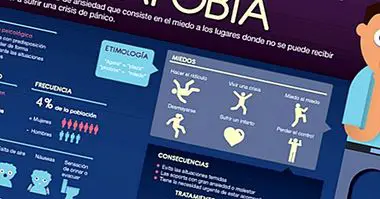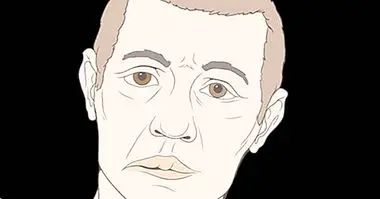The differences between anxiety and anguish
Concepts such as anxiety, anguish and stress have become widespread nowadays. It seems to be usual that we ourselves or someone from our environment has suffered at some point these problems. It would not be difficult to agree that all refer to unpleasant states, which can range from momentary discomfort to widespread fear or terror, which can extend to overwhelm us on a day-to-day basis.
Beyond understanding them as problems, do we know the differences between each concept? Is it possible that the confusion between terms makes our approach difficult?
The following is intended to provide information on the origin and nuances of each concept and of the differences between anxiety, anguish and its relationship with stress , to clarify the ideas we have and perhaps, provide a little light when facing each of them.
- Perhaps you are interested: "Anguish: symptoms, causes and possible treatments"
Fear as an adaptive resource
Human beings have natural resources for protection against danger, which is sometimes known as adaptive anxiety or fear. It would be like a tool that would act as a warning signal in the face of danger. For example, imagine the following situation:
"We are walking calmly down an avenue, and we hear cries of terror and we see people running in one direction. Without thinking, we run faster than ever, looking for somewhere to take refuge. "
In this situation, the interpretation of danger has been automatic , since it has generated the response of the sympathetic nervous system (SNS), key activation in what is known as the "E situations" (escape, stress, emergency). When SNS is activated, hormones are released to increase blood pressure (such as cortisol) and neurotransmitters to prepare an explosive muscular action (catecholamines such as adrenaline, norepinephrine and dopamine) that allow this escape reaction and therefore , protection from a dangerous situation. At this point, fear protects us from imminent danger and, therefore, has an important functional value.
In this situation, Do we act based on fear or anxiety? The key difference between the two is that anxiety is related to anticipation, that is, to future, diffuse or unpredictable dangers, while fear is related to one or several present stimuli or situations.
Now, what happens if this adaptive mechanism is related to stimuli or situations that do not represent a real danger or threat? In spite of the individual differences and the particular way of living of each person, if the generalized fear or anxious state is maintained and intensified, both in duration and in frequency, generates negative consequences for comprehensive health of the person to be treated.
Differences between anxiety and anxiety
At the beginning of the 20th century, Sigmund Freud was the first to introduce the concept of anguish in a technical way He used the German term Angst to refer to a state of mind, with negative affect, with the consequent physiological activation and, most importantly, based on something indeterminate, that is, with no known or definable object.
This concept was translated into English as anxiety and in Spanish It was translated with double meaning: anxiety and anguish . From here it could be understood that the two concepts appear as synonyms, in nonclinical settings, up to the present, used to describe an unpleasant psycho-physiological state, which occurs with great restlessness, restlessness, unrest before imprecise dangers and / or that generate a exaggerated and maladaptive fear for daily life.
Although they are used as synonyms in a colloquial way, In the current clinical setting, the differentiation between anxiety and anxiety appears . The most widely used tool internationally for the classification of mental disorders is the DSM-V (Diagnostic and Statistical Manual of Mental Disorders), which includes a section dedicated to anxiety disorders.
In this manual, anguish is treated as a subtype of anxiety disorders. In this sense, anguish is defined as what is commonly known as "panic attack" , explained as an episode of intense fear that has a short duration. On the contrary, the anxiety would refer to a state that permenece more in time.
The anxiety can be found in a generalized way in multiple events or it can be manifested in different areas and for different reasons or causes.At this point, the different known phobias (social phobia, agoraphobia, obsessive-compulsive disorder, phobias before a specific stimulus ...) would have as an engine the anxiety but they would be differentiated according to the manifestations or the triggering events.
Anxiety as such, beyond the nuances or explanations provided by the different currents within Psychology (psychoanalysis, gestalt, cognitive-behavioral ...) must be understood from its complexity, since it encompasses a multidimensional response. This means that includes cognitive, emotional and physiological aspects , characterized by an activation of the autonomic nervous system (formed by the sympathetic and parasympathetic nervous system) that tends to generate maladaptive behaviors and which can sometimes involve a high risk for the person suffering it.
- Maybe you're interested: "The 31 best Psychology books you can not miss"
Stress: set of physical, psychological and social ailments
Once the concepts of anxiety and anguish have been explained, the concept of stress can be understood, which can include the previous ones. In summary, stress could be understood as a negative relationship between the person and the environment . This maladaptive relationship between the environment and the person is dynamic, bidirectional and changing, but its core is the fact that the person perceives that he can not face environmental demands.
The situation is understood as a set of factors that exceeds the available resources. At this point, the person could develop anxiety, anguish and other diverse physical and psychological problems, which would have as a common point the generation of a deep malaise .
The complexity of relationships between the person and the environment make it a priority that both anxiety, anxiety and stress are approached from a broad perspective and attending to the multiplicity of factors involved (physiological, cognitive, emotional, social ...) .
Given the influence of social factors in the implication of these problems that are already becoming known as "diseases of the 21st century", it is the responsibility of all people who know each other, in order to detect them and work on their management, especially in the prevention of same. If a person perceives some type of related problem, either in herself or in someone in her environment, It is advisable that you attend to the symptoms, ask for help and as soon as possible better , to avoid that these generate more serious consequences.
- Related article: "10 essential tips to reduce stress"
Bibliographic references:
- American Psychiatric Association. "Diagnostic and statistical manual of mental disorders DSM-V." Washington: APA (2013).
- Martínez Sánchez, F. & García, C. (1995). Emotion, stress and coping. In A. Puente (Ed.), Basic Psychology: Introduction to the study of human behavior (pp. 497-531). Madrid: Pyramid.
- Sierra, Juan Carlos, Virgilio Ortega, and Ihab Zubeidat. "Anxiety, anguish and stress: three concepts to differentiate." Discomfort and Subjectivity Magazine 3.1 (2003).



















